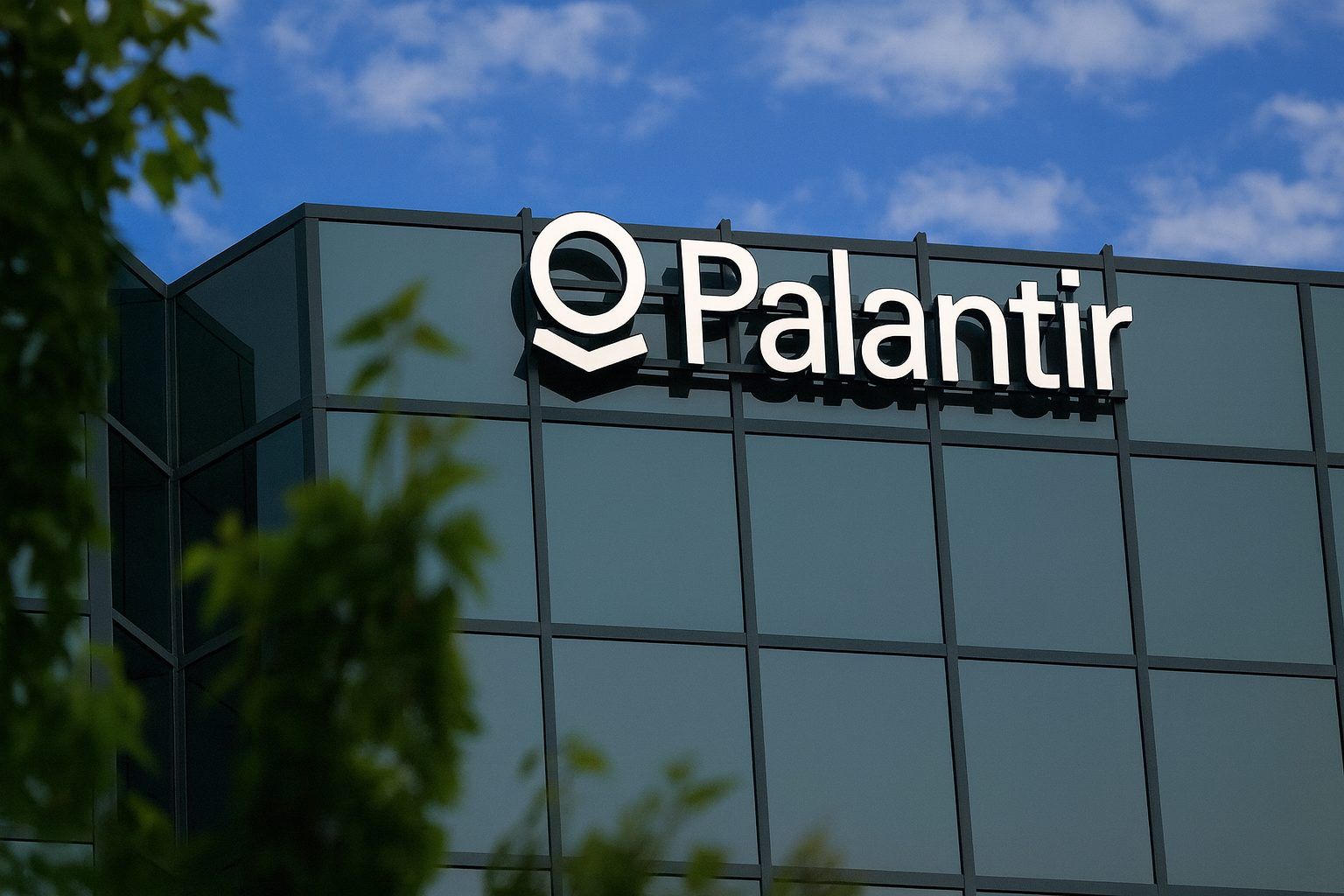Data as of the latest intraday trading on November 25, 2025. Figures may change by the close.
PLTR stock today: small red day after a massive run
Palantir Technologies Inc. (NASDAQ: PLTR) is trading around $161 per share today, down less than 1% in a relatively modest pullback after one of the most spectacular multi‑year runs in the market. [1]
Even after the recent slide, Palantir is still up well over 100% in 2025 and has soared several hundred percent over the past three years, making it one of the standout performers in the S&P 500 during the AI boom. [2]
But the mood around PLTR has clearly shifted this month:
- The stock hit an all‑time high near $207 earlier in November. [3]
- It has since fallen roughly 20–25% from that peak as investors question whether the valuation has simply gone too far. [4]
- At current levels, Palantir still commands a market capitalization in the $370–$400 billion range and trades at hundreds of times earnings, depending on which metric you use. [5]
That combination—huge gains, extreme valuation, and a sharp pullback—is exactly why PLTR is front and center for traders and long‑term investors alike today.
Why Wall Street is suddenly nervous about PLTR
1. Valuation: from “rich” to “almost unprecedented”
Even by high‑growth tech standards, Palantir’s multiples are eye‑popping:
- Roughly 360x trailing earnings and about 150x forward earnings, according to recent breakdowns from market commentators and analyst data. [6]
- A price‑to‑sales (P/S) ratio around 120–130x, versus single‑digit or low‑double‑digit P/S multiples for mega‑caps like Alphabet, Microsoft and even AI bellwether Nvidia. [7]
- The Economist has gone as far as describing Palantir as possibly one of the most over‑valued companies of all time, noting that as of November 2025 it is among the most expensive names in the S&P 500 on forward sales metrics. [8]
A fresh piece from 24/7 Wall St. published today bluntly argues that Palantir “could be the most overvalued company that ever existed,” pointing out that at roughly $155–$160 per share, the company’s valuation assumes decades of very high growth to be justified. [9]
In short: even bullish analysts generally concede that Palantir is priced for near‑perfection.
2. Insider selling: CEO and top executives cash out
The timing of heavy insider selling is amplifying those valuation concerns.
- CEO Alexander Karp sold about $66 million worth of PLTR stock on November 20–21 under a trading plan, part of roughly $162 million in total insider sales over recent weeks. [10]
- President Stephen Cohen reportedly sold around $56–57 million worth of shares, according to regulatory filings highlighted by GuruFocus and TradingView’s news feed. [11]
- In total, several executives and directors have collectively unloaded well over $150 million of stock in a short span. [12]
Insider sales don’t automatically mean trouble—executives diversify, exercise options, and manage taxes—but the optics are tough when:
- The stock has just rallied to record highs, and
- Commentators are already questioning whether PLTR’s valuation has entered bubble territory.
Some analysts frame this as insiders simply taking advantage of extraordinary gains; others see it as a possible signal that risk‑reward is less favorable at current prices.
3. The Michael Burry overhang and short‑seller narrative
Fueling the bearish story further is the involvement of famed investor Michael Burry, whose fund disclosed a bearish position against Palantir earlier this month. [13]
This has fed a narrative that PLTR may be “the short of the decade” for investors betting on AI euphoria cooling. Combined with sensational headlines and social‑media debate, this has helped turn Palantir into a battleground stock, with vocal bulls and critics locked in a tug‑of‑war.
Under the hood: Palantir’s fundamentals are still exploding higher
The difficulty with PLTR is that the business looks much better than skeptics would like to see—at least for now.
Blockbuster Q3 2025
Multiple sources and company disclosures paint a picture of a company in hyper‑growth mode:
- Revenue surged roughly 60–63% year over year in Q3 2025, to around $1.18 billion, beating consensus estimates. [14]
- Commercial revenue is now growing faster than government revenue:
- Commercial sales jumped over 70% year over year, to about $548 million, and continued to outpace the U.S. government segment for a fourth consecutive quarter. [15]
- Palantir posted one of its strongest profitability performances yet, with GAAP net income approaching $476 million and margins around 40%, according to earnings call summaries and investor materials. [16]
- Management raised full‑year guidance, pointing to over 50% revenue growth for 2025 and sharply higher operating income and free cash flow projections. [17]
In other words: Palantir isn’t just a story stock anymore—it’s a highly profitable one.
AIP: the AI platform driving commercial growth
A major pillar of the bull case is Palantir’s Artificial Intelligence Platform (AIP), which allows enterprises to integrate their own data with advanced AI and decision‑making tools.
Recent coverage highlights several key data points: [18]
- U.S. commercial revenue more than doubled year over year, as companies in sectors like healthcare, finance and manufacturing race to deploy AI in real operations.
- Customer count jumped, with some analyses citing growth of around 40–45% year over year, and contract value reaching record levels as existing customers expand their usage.
- Palantir raised its outlook for U.S. commercial revenue to more than $1.4 billion in 2025, implying triple‑digit growth for that segment.
For bulls, AIP isn’t just another software product; it’s pitched as an “operating system for the modern enterprise in the era of AI”, with long‑term recurring revenue and high switching costs. [19]
Big‑ticket defense and energy deals are reshaping the story
Palantir’s roots are in government and defense, and that side of the business is also seeing step‑change growth.
$10 billion U.S. Army enterprise agreement
In late July, the U.S. Army consolidated dozens of separate Palantir contracts into a single enterprise agreement that allows it to purchase up to $10 billion of Palantir’s software over ten years. [20]
- The deal doesn’t guarantee that the full $10 billion will be spent, but it dramatically simplifies procurement and gives Palantir a powerful preferred‑vendor position.
- Analysts say this effectively cements Palantir as a core data and AI infrastructure provider for the Army, and could create a blueprint for similar frameworks with other branches or allied governments. [21]
AI for nuclear and other critical infrastructure
Palantir isn’t just about defense contracts anymore:
- Its shares recently hit record levels after announcing a strategic partnership with a U.S. nuclear power developer, building an AI‑driven software system to manage large‑scale nuclear plant construction. [22]
- The company has also expanded deals across NATO, ICE, and the U.S. Air Force, as well as new partnerships like its collaboration with Exiger to bring AI‑driven supply‑chain visibility tools to the Army. [23]
These contracts reinforce a key point for bulls: Palantir’s software increasingly sits at the heart of mission‑critical systems—from military logistics to energy infrastructure—making it hard to rip out and potentially giving the firm years of high‑margin revenue.
The bull vs. bear debate on PLTR, in plain English
The bull case: “This is the AI operating system”
Supporters of PLTR argue that:
- Structural tailwind
AI is still early; estimates peg the global AI market reaching trillions of dollars in size by 2030, with Palantir well positioned as a core software layer for both governments and enterprises. [24] - Scarce, profitable leader
Unlike many AI hopefuls, Palantir is already solidly profitable with expanding margins and a growing cash pile. [25] - Deep moat in sensitive sectors
Its long history working with intelligence agencies, defense, and regulated industries is hard to replicate, especially when data security, clearance and compliance are paramount. [26] - Cult‑like investor base
Palantir has become something of a “cult stock” with a passionate retail following that sees the company as a generational AI winner—some early believers have already become millionaires on paper. [27]
For this camp, valuation is high but justifiable if Palantir continues to compound revenue at 30–40% annually for many years, while maintaining elite margins and deepening its moat.
The bear case: “Great company, dangerous price”
Skeptics agree that Palantir’s technology is powerful—but argue the stock price has detached from reality.
Common bear arguments include:
- Extreme multiples leave no margin of safety
With P/E and P/S ratios many times higher than other AI leaders, even a small slowdown in growth or a single disappointing quarter could trigger a brutal repricing. [28] - Insider and institutional selling
Heavy selling by insiders and reductions in positions by notable institutional investors are seen as evidence that sophisticated players are locking in gains and de‑risking exposure. [29] - Government concentration and political risk
Government work still accounts for a large chunk of revenue; changes in budgets, politics, or contract rules could disproportionately impact Palantir. [30] - Rising competition in enterprise AI
Hyperscalers and other AI software vendors are rapidly expanding their own platforms. Bears worry that over time, more modular, cheaper AI tools could compress Palantir’s pricing power, especially in the commercial segment. [31]
Some bearish analysts and commentators even project potential downside of 30–70% if multiples normalize to more typical (though still generous) growth‑stock levels. [32]
What today’s move in PLTR might be telling investors
With PLTR only slightly lower today despite noisy headlines about insider selling and valuation fears, the market seems to be wrestling with two truths at once:
- The business is undeniably strong right now—revenue is growing fast, margins are expanding, and Palantir keeps landing high‑profile AI and defense deals. [33]
- The stock is priced for perfection—and any wobble in growth, sentiment, or macro conditions could lead to sharper corrections, as we’ve already seen with the 20–25% drop from this month’s high. [34]
Whether today’s modest dip is a healthy pause or the start of a more prolonged re‑rating will likely depend on a few key variables over the coming weeks and months:
- New contract announcements and partnerships, especially large defense or critical‑infrastructure deals.
- Updates on AIP adoption, customer additions, and contract value growth.
- Further insider trading disclosures—whether sales continue at the recent pace or cool off.
- Macro and AI‑sector sentiment, including any broader tech sell‑offs or shifts away from high‑multiple growth names.
Key things for PLTR watchers to monitor
If you’re following Palantir stock closely, here are some metrics and themes to keep on your radar:
- Revenue growth trajectory: Does Palantir sustain ~40–60% growth, or does it naturally slow as the base gets larger? [35]
- Commercial vs. government mix: Continued outperformance from the commercial segment would support the higher multiple by diversifying away from pure government dependence. [36]
- Operating margin and free cash flow: High‑margin, cash‑rich AI leaders can sometimes justify premium valuations, but only if that profitability proves durable. [37]
- Valuation vs. peers: Comparing PLTR’s multiples with those of Nvidia, Microsoft, Alphabet and other AI names can help frame just how much future growth is already “priced in.” [38]
- Regulatory and political developments: Given Palantir’s deep entanglement with defense, intelligence and public‑sector work, changes in oversight or contract policy could matter more here than for typical software firms. [39]
Bottom line
Palantir today is a paradox:
- Fundamentally, it looks like one of the strongest AI‑software stories in the market, with rapid growth, rising profits, and entrenched positions in critical government and enterprise systems.
- From a valuation standpoint, it is arguably among the most expensive large‑cap stocks in history, with insiders and some high‑profile investors signaling caution even as loyal believers lean in. [40]
For traders, that mix means volatility is likely to remain high. For long‑term investors, it means the PLTR decision is less about whether Palantir is a good business (it is) and more about how much growth you’re willing to pay for today.
Disclosure: This article is for informational and educational purposes only and does not constitute financial advice, investment recommendation, or an offer to buy or sell any security. Always do your own research or consult a licensed financial professional before making investment decisions.
References
1. www.nasdaq.com, 2. www.reuters.com, 3. parameter.io, 4. www.inkl.com, 5. 247wallst.com, 6. 247wallst.com, 7. www.inkl.com, 8. en.wikipedia.org, 9. 247wallst.com, 10. parameter.io, 11. www.tradingview.com, 12. parameter.io, 13. www.marketwatch.com, 14. simplywall.st, 15. www.inkl.com, 16. finance.yahoo.com, 17. investors.palantir.com, 18. www.inkl.com, 19. 247wallst.com, 20. www.reuters.com, 21. www.fedsavvystrategies.com, 22. www.investopedia.com, 23. simplywall.st, 24. 247wallst.com, 25. en.wikipedia.org, 26. fedscoop.com, 27. www.marketwatch.com, 28. 247wallst.com, 29. parameter.io, 30. www.reuters.com, 31. www.tradingview.com, 32. 247wallst.com, 33. simplywall.st, 34. www.inkl.com, 35. simplywall.st, 36. www.inkl.com, 37. en.wikipedia.org, 38. www.inkl.com, 39. fedscoop.com, 40. 247wallst.com







